EVALUATION OF THE SALIVA CORTISOL LEVELS IN PATIENTS UNDER PROSTHETIC TREATMENT DUE TO FUNCTIONAL DISORDERS OF THE MASTICATORY ORGAN
INTRODUCTION
One of the main etiological factors of the functional disorder syndrome affecting the stomatognathic system is the psychological factor, related to excessive emotional sensitivity of patients and the difficulties in coping with stressful situations. The detrimental effects of stress may be multidirectional and can also affect the general health condition, generating the development of psychosomatic or somato-psychic diseases. The degree of the harmful effect exerted by stressors depends on the strength of the incentive, individual predispositions of a patient and his/her adaptation abilities (1-8).
Cortisol is a hormone produced by fascicular zone of the adrenal cortex, belonging to the glycocorticosteroidal group of hormones. Its secretion is controlled by the adrenocorticotropic hormone (ACTH), produced in the pituitary gland, and indirectly by corticotropin-releasing hormone (CRH) of the hypothalamus. The secretion of cortisol is subject to a diurnal rhythm and the highest concentration can be observed in the morning hours, around 9 o’clock. It performs numerous functions in the body, such as the control of glucose homeostasis (along with insulin and glucagon), the control of the lipolysis of fatty cells and the control of immune system suppression through its effect on the concentration and migration of leukocytes. This also influences the central nervous system thanks to the synthesis of neurotransmitters and receptors. It is also considered as a “stress hormone”, because in stressful situations its levels in the blood and the saliva considerably grow (9, 10).
Generally, cortisol levels are marked in the blood, but it is also possible to mark the level of this hormone in other biological specimens, such as urine and saliva. Based on the findings, it was discovered that there is a close correlation between blood cortisol levels and non-stimulated saliva ones. The saliva cortisol amount is not dependent on the saliva secretion rate. The correlation between saliva cortisol and the unbound cortisol in the blood is approximately 80%. This high level of compatibility results from the fact that cortisol enters the cells and the oral cavity mainly through passive diffusion. The total saliva cortisol level is lower in the blood due to high concentrations of the cortisol metabolising hormone - 11β-hydroxysteroid dehydrogenase (11). It must be stressed that saliva, as a specimen collected in a non-invasive manner and without the presence of specifically trained personnel, is a valuable material in hormone diagnostics. Additional benefit is the reduction in the risk of infections related with taking the peripheral blood, less stress during saliva collection when compared to the blood as well as easy transportation of the saliva. Another important factor is the high stability of the level of numerous hormones in this diagnostic material (12-14).
An endogenic cause of excessive cortisol levels may be the Cushing’s syndrome (pituitary adenomas and extrapituitary tumours) and tumours of the adrenal gland. The causes of exogenous hypercortisolemia most often include the ingestion of corticosteroids. The functional base of increased cortisol level is often associated with obesity, depression, anxiety disorders and alcoholism. In cases where hormonal disorders, over consumption of drugs and the above-mentioned diseases are excluded, it is stress that is responsible for excessive cortisol levels. It was also verified that a drug therapy applied in depressive patients leads to the reduction in cortisol secretion. Therefore non-randomised open studies were undertakenin order to perform comparative analysis of saliva cortisol levels in patients treated for the painful form of functional masticatory system dysfunctions and in healthy individuals with no dysfunctions in the stomatognathic system (9, 10).
MATERIALS AND METHODS
Patients
The study was approved by the Bioethical Committee of the Jagiellonian University, approval no. KBET/278/B/2011.
The study materialencompassed 60 individuals, of both sexes, divided into two groups. One was composed of patients aged 20 to 46, who had been treated due to the painful form of functional masticatory system dysfunctions at the Dental Prosthetic Out-Patient Clinic of the Dental Institute JUMC in Cracow, in the years from 2011–2013. The control group was made up of 30 individuals, of both sexes, aged 19 to 41, in whom - on the basis of specialist examinations - the presence of stomatognathic system dysfunctions were excluded. All of the subjects were free from endocrynological diseases associated with functional hypercortisolemia and had not been subjected to corticosteroid therapy for the previous 4 years, which would have affected the assessed cortisol levels.
The following tests were conducted: physical examination, medical history and specialist functional testing along with additional diagnostics (panoramic radiogram assessment, assessment of the temporomandibular joints), aimed at diagnosing or excluding masticatory system dysfunctions, performed in accordance with the questionnaire applicable at the Masticatory System Functional Disorders Laboratory of the Dental Prosthetics Chair of the Dental Institute (IS) in Cracow in order to identify the test group and the control group.
The non-stimulated saliva collection was conducted in all the subjects at the same hour, i.e. 9 am, in the amount of 2 ml, into plastic Eppendorf test tubes. Immediately upon collection, the saliva was frozen in the temperature of –18°C. Patients were informed not to consume any means or drink any beverages apart from water one hour before the examination. The test tubes were marked with a red tape for patients treated due to functional disorders and were numbered from 0 to 30. A green tape was used to mark the healthy individuals, numbering the test tubes from 31 to 60 (Fig. 1).
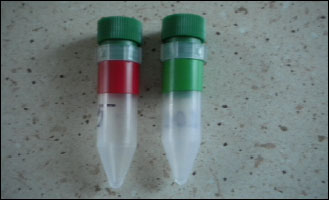 |
Fig. 1. Eppendorf tube marked with a red tape for patients belonging to the Group I and green to control Group II. |
Cortisol levels were marked with the use of high performance liquid chromatography (HPLC) with UV detection at the Faculty of Analytical Chemistry of the Pharmaceutical Department of the University of Gdansk (the Laboratory Medicine Section). The test tubes containing frozen saliva were transported within 12 hours in freezer conditions, and an increase of tested material temperature during transportation had no influence on a change in the levels of the marked hormone. The physiological level of cortisol has been assumed as 5 ng/ml of saliva. Carbamazepine (quantity: 100 µl, concentration: 1 µl/ml) and then dichloromethane were added to the saliva. The sample was subjected to mixing and spinning for 20 minutes. The layer of dichloromethane was moved to glass test tubes and evaporated in a waterbath. Chromatographic analysis was conducted with the use of Nucleosil 100-5 column with a reversed phase C18, the length of the detector waves was 240 nm, using the apparatus presented in Fig. 2 (11).
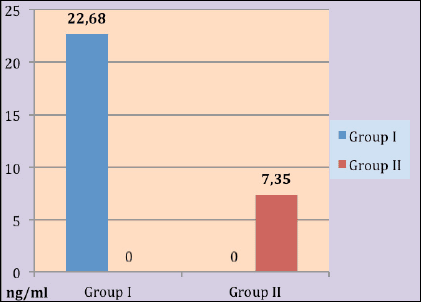 |
Fig. 2. The average values of cortisol obtained in saliva in group I and II. |
The psychological test, which lasted 20 minutes, was conducted with the participation of a psychologist on the basis of the survey paper-pencil method. In order to assess the patient psychological profile and their behaviour in stressful situations, the CISS (Coping Inventory for Stressful Situations) survey was used, which provided the answer to the question of how the patient behaves in and copes with difficult, stressful situations, assuming one of the three possible coping styles. The questionnaire consists of 48 statements concerning various behaviour types that may be chosen by people in stressful situations. The findings are placed within three scales: ask-focused style (SSZ); emotion-focused style (SSE); avoidance-focused style (SSU).
The task-focused style scale determines the style of coping with stress which is about undertaking tasks. The individuals who reach high results in this scale are - in stressful situations - inclined to undertake efforts aimed at solving a problem through cognitive transformations or attempted to change the situation. Main stress in placed on the task or planning of problem solution.
The scale of the emotion-focused style (SSE) concerns the style typical of people who, in stressful situations, are prone to concentrate on themselves, on their own emotional experiences such as anger, the feeling of guilt or tension. These people are inclined to indulge in wishful thinking and fantasising. Such actions are aimed at reducing the emotional stress related to a stressful situation. However, they may occasionally intensify the feeling of stress, and cause increased tension or depression.
The avoidance-focused style (SSU) defines a style of stress coping typical of people who are, in stressful situations, prone to avoid thinking, contemplating and experiencing the situation. This style may assume two forms: engaging in replacement activities (ACZ) or searching for contacts (PKT).
To compare average values in a group of healthy and sick persons the t-test for independent variables, and the nonparametric equivalent Mann-Whitney test was used. Empirical compliance of characteristics distribution of the theoretical normal distribution was based on the Shapiro-Wilk test.
Relationship between two variables were tested by chi-square independence. Results were considered statistically significant if the P value did not exceed the significance level 0.05. Calculations were performed using IBM SPSS v.22 (IBM, New York, USA).
RESULTS
The average cortisol level values marked in the morning hours in the test group amounted to 22.68 ng/ml, with extreme values equal to 5.37 and 75.0 ng/ml. In the control group, these results were much lower and amounted to 7.35 ng/ml, with extreme values reaching 0.5 and 17 ng/ml. Standard deviation in the patient group of functional dysfunctions of the masticatory system amounted to 17.25, and in the healthy individuals - 4.05. The above results are incorporated in Table 1, with their graphic representation in Fig. 3.
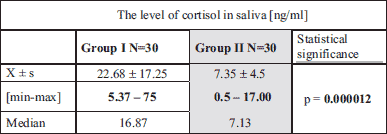
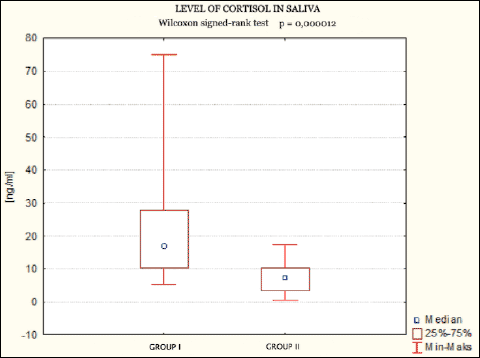 |
Fig. 3. The results of the statistical analysis are presented graphically. |
Statistical analysis indicated that the average cortisol levels marked in the saliva in both groups differ in a statistically significant manner, because P is lower than 0.05. These results are presented in Table 1.
The findings of the CISS questionnaire also indicated differences between the test group and the control group (Fig. 4).
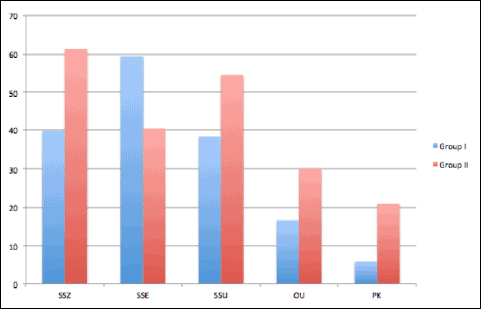 |
Fig. 4. Avarage values of scores obtained in CISS questionnaire by I and II group. |
In each of the rating scales, the mean values obtained by the test group were less favourable compared to the results obtained by the healthy subjects (i.e. significantly lower average values in the case of SSZ score, much higher - in the case of SSE, and lower in the case of SSU). What should also be noted are the minimum values that are significantly higher in the study group than in the control group in all the scales of the questionnaire (Table 2). The evaluated results in the individual styles differ between the groups in a statistically significant manner because P is less than 0.05.

DISCUSSION
The masticatory system dysfunctions often lead to numerous diagnostic and therapeutic problems due to their complex etiology.
One of the symptoms of functional disorders of the stomatognathic system are disturbances in the functioning of the masticatory muscles, manifested by increased tension, hypertrophy, and the lack of symmetry of their action. In Turturicii and Roatta studies (15) the differences in blood flow in the masticatory muscles in 6 anesthetized rabbits were evaluated, using repetitive mechanical stimuli. The results provide evidence that the mechano-sensitivity of the vascular network is attenuated by previous mechanical stimulation. It is suggested that the mechano-sensitive dilatory mechanisms undergoes some inactivation whose recovery time is in the order of a few minutes.
Kunert Keil et al. conducted studies on the expression of genes affecting calcium homeostasis in mice masseter muscle suffering from muscular dystrophy (16). Their findings revealed that masticatory muscles showed an unequally altered expression of genes involved in the Ca2+ homeostasis that can support the differences in masticatory muscles response to dystrophin deficiency. It can be assumed, that some part of masticatory system dysfunctions may have a genetic aetiology.
Own experience indicates that ignoring the presence of psychoemotional disorders in the treatment plan may be the source of failure of prosthetic therapies, because the commonly used occlusal devices and a supportive treatment may prove to be insufficient or cause relapses of the pain symptoms located in the musculo-articular system (14, 17-20).
The findings of the studies conducted indicate a significantly higher saliva cortisol levels in patients with a stomatognathic system dysfunction as compared with healthy individuals with no such dysfunctions. This confirms the strict correlation and the influence of psychoemotional factors on the etiology of this disease (1, 2, 4-7, 21). Besides the average values obtained in both groups, attention is attracted by the extreme values, which amount to 5.37 and 75 in the patient group, i.e. the maximum value exceeds the norm in this regard 15 times, and in the group of healthy individuals, these values amount to 0.5 and 17 ng/ml of saliva.
Studies on saliva cortisol concentration and the activity of the stomatognathic muscles during stressful situations were conducted by Bakke et al. (22). The findings confirmed the saliva cortisol levels increase in response to the stressor and to the higher tension of the stomatognathic system muscles.
Functional disorders of the stomatognatic system leads to pathological changes in the temporo-mandibular joints such as damage of the articular disc and articular capsule. One of the treatment methods of temporo-mandibular joint dysfunction are intra-articular injections of platelet-rich plasma (23). Favorable results also have been reported in studies in which stem cells have been used in the treatment of periodontal diseases (24).
Disorders in the functioning of the hypothalamic-pituitary-adrenal axis manifested by increased cortisol levels are often the symptom of affective disorders in the form of depression, lability and emotional irritability, difficulties in concentration, sleeping problems and increased susceptibility to emotional stress. This also means increased irritability, anxiety and panic seizures (10). These symptoms, along with somatic changes and introvertism, are conducive to the development of the syndrome of functional masticatory system dysfunctions and may not be omitted in the prosthetic treatment plan. In practice, we often find the presence of the above personal traits and the difficulties that patients report during physical examination (1, 2, 4-7).
Stress has a damaging effect on the stomatognathic system due to the limbic system and the gamma loops, which are responsible for the pathological increase in muscle tension of the masseters (mastication muscles), thus leading to numerous unfavourable changes (1, 4-6). The studies by Nater et al. confirmed the significant increase in cortisol and alpha-amylase levels in the saliva, induced by an experimental psychological stress (19). Cortisol, as a hormone whose levels are correlated with the occurrence of stress and psychological tension, may constitute a precious marker for the co-existence of emotional disorders among etiological factors of the dysfunctions as well as a basis for combined treatment, i.e. prosthetic-psychological therapy for this group of patients (9, 10, 14, 21, 25, 26). Moreover, hypercortisolemia found upon additional tests on patients with stomatognathic dysfunction may be an indication for endocrynological consultation, associated with the disorders of the metabolism of lipids and carbohydrates (diabetes, elevated cholesterol levels, restricted field of vision) in the patients under treatment (9, 18).
Patients of the test group indicated high point values in the emotion-focused style. It is typical of individuals who focus on themselves and their own emotional experiences, such as anger, the feeling of guilt, tension.
It seems that the base for the development of this type of strategies may only be associated with certain personality- and temper-based conditions. In their studies, Endler and Parker indicated a link between an emotion-focused style and neuroticism (27). Szczepaniak et al. also proved that there is a positive correlation between the emotional style of coping with stressful situations and high levels of emotional anxiety (28). This style seems particularly ineffective against such difficult situations in which an individual could influence the course of events, and so, secondarily, also his/her own emotional state, by taking concrete actions. The fundamental consequence of using this type of strategy of stress coping is the omission to take actions.
Patients from the test group at the same time reached significantly higher results for the avoidance-focused style than the individuals from the control group. This difference mainly concerned the strategies oriented on the search of social contacts, which indicates that, in stressful situations, such people are inclined to avoid thinking, contemplating and experiencing difficult situations by frequent interaction with other people. Here, it must be emphasised that this strategy has little in common with the search for support in solving a problem or reduction in the emotional tension experienced - in this case, an individual engages in social activities so as to free his/her mind from the current problem.
Finally, the patients from the test group and the individuals from the control group used the task-focused style to a comparative extent. Therefore, we might conclude that both subject groups are equally regular in undertaking efforts oriented on solving difficult situations. It seems to be crucial in this context to answer the question about the types of stressors that the subjects need to cope with. An interesting aspect in the planning of further studies was the incorporation of the possibility of influence on the subsequent course of a stressful situation in the context of experimental stressors. The observed difference could concern the higher frequency of launching the task-oriented strategy in the test group towards situations, which the individual - as a rule - has limited influence on.
In summary, we found a significantly higher cortisol levels assessed in the saliva in patients with functional disorders as compared with healthy individuals with no dysfunctions in the stomatognathic system.
Moreover, the psychological test applied, based on the CISS survey, highlighted essential differences in the stress coping strategies adopted by the patients with functional disorders and by the healthy individuals, with the majority of patients with masticatory system dysfunctions choosing the avoidance-focused and emotion-focused strategies. This confirms the correlation and the influence of psychoemotional factors on the etiology of this disease.
Conflict of interests: None declared.
REFERENCES
- Okeson JP. Management of Temporomandibular Disorders and Occlusion. Porgeburst E-Book on VitalSource, 7th Edition, Elsevier, 2013, pp. 26-45, 173-211.
- Grey R, Al-Ani Z. Temporomandibular Disorders. A Problem-Based Approach. Wiley-Blackweel, 2011, pp. 12-19, 22-45.
- Ash MM. Current concepts in the aetiology, diagnosis and treatment of TMJ and muscle dysfunction. J Oral Rehabil 1986; 13: 1-20.
- Teichman H., Majdanska Z. The influence of psychological factor for complaints in stomatognathic system - selected caces. Protet Stomatol 2000; 50: 272-282.
- Wasilewska A., Slowinska S. Pathogenic effects of stress on the masticatory system. Nowa Stomatologia 2002; 4: 204-206.
- Celic R, Panduric J, Dulcic N.Psychologic status in patients with temporomandibular disorders. Int J Prosthodont 2006; 19: 28-29.
- Meldolesi G, Picardi A, Accivile E, Toraldo di Francia R, Biondi M. Personality and psychopathology in patients with temporomandibular joint pain-dysfunction syndrome. A controlled investigation. Psychother Psychosom 2000; 69: 322-328.
- Rollman GB, Gillespie JM. The role of psychosocial factor in temporomandibular disorders. Curr Rev Pain 2000; 4: 71-81.
- Dziurkowska E, Wesolowski M. Saliva – the valuable biological material for determining of cortisol level. Farmac Przegl Nauk 2010; 12: 21-26.
- Jones DA, Rollman GB, Brooke RI. The cortisol response to psychological stress in temporomandibular dysfunction. Pain 1997; 72: 171-182.
- Kirschbaum C, Hellhammer DH.Noise and stress– salivary cortisol as a non-invasive measure of allostatic load. Noise Health 1999; 1: 57-66.
- Putignano P, Dubini A, Toja P, et al. Salivary cortisol measurement in normal-weight, obese, and anorexic women: comparison with plasma cortisol. Eur J Endocrinol 2001; 145: 165-171.
- Doepel M, Soderling E, Ekberg EL, Nilner M, Lebell Y. Salivary cortisol and IgA level in patients with myofacial pain treated with occlusal appliances in the short term. J Oral Rehabil 2009; 36: 210-216.
- Okamoto K, Thompson R, Katagiri A, Bereiter D. Estrogen status and psychophysical stress modify temporomandibular joint input to medullary dorsal horn neurons in a lamina-specific manner in female rats. Pain 2013; 154: 1057-1064.
- Turturici M, Roatta S. Inactivation of mechano-sensitive dilatation upon repetitive mechanical stimulation of the musculo-vascular network in the rabbit. J Physiol Pharmacol 2013; 64: 299-308.
- Kunert-Keil Ch, Gredes T, Lucke S, Botzenhart U, Dominiak M, Gedrange T. Differential expression of genes involved in the calcium hemostasis in masticatory muscles of mdx mice. J Physiol Pharmacol 2014; 65: 317-324.
- Ida M, Ida I, Wada N, Sohmiya M, Tazawa M, Shirakura K. A clinical study of the efficacy of a single session of individual exercise for depressive patients, assessed by the change in saliva free cortisol level. Biopsychosoc Med 2013; 7: 18-22.
- Sherman JJ, Le Resche L, Huggins KH, Mancl LA, Sage JC, Dworkin SF. The relationship of somatization and depression to experimental pain response in women with temporomandibular disorders. Psychosom Med 2004; 66: 852-860.
- Nater U, La Marca R, Florin L, et al. Stress-induced changes in humane salivary alpha-amylases activity-associations with adrenergic activity. Psychoneuroendocrinology 2006; 31: 49-58.
- Izawa S, Saito K, Shirotsuki K, Sugaya N, Nomura S. Effect of prolonged salivary costisol and dehydroepiandrosterone: a study of a two-week teaching practice. Psychoneuroendocrinology 2012; 37: 852-858.
- Reissmann DR, John MT, Schierz O, Wassell RW. Functional and psychosicial impact related to specific temporomandibular disorders diagnoses. J Dent 2007; 35: 643-650.
- Bakke M, Tuxen A, Thomsen CE., Bardow A, Akjear T, Jensen BR. Salivary cortisol level, salivary flow rate, and masticatory muscle activity in response to acute mental stress: acomparision between aged and young women. Gerontology 2004; 50: 383-392.
- Pihut M, Szuta M, Ferendiuk E, Zenczak-Wieckiewicz D. Evaluation of pain regression in patients with temporomandibular dysfunction treated by intra-articular platelet-rich plasma injections: apreliminary report. Biomed Res Int 2014; 2014: 132369. doi: 10.1155/2014/132369
- Racz GZ, Kadar K, Foldes A, et al. Immunomodulatory and potential therapeutic role of mesenchymal stem cells in periodontitis. J Physiol Pharmacol 2014; 65: 327-339.
- Huang F, Zhang M, Chen YJ, Li Q, Wu AZ. Psychological stress induces temporary masticatory muscle mechanical sensitivity in rats. J Biomed Biotechnol 2011; 2011: 720603.
- Dziurkowska E, Wesolowski M. Evaluation of two techniques for extraction of cortisol from human saliva. Chromatographia 2009; 70: 769-774.
- Endler NS, Parker JD. Coping Inventory for Stressful Situation(CISS): Manual. Toronto, Multi-Health Systems Inc., 1990.
- Strelau J, Jaworowska A, Wrzesniewski K, Szczepaniak P. CISS. Kwestionariusz Radzenia Sobie w Sytuacjach Stresowych. Warszawa, Pracownia Testow Psychologicznych PTP, 2013.
A c c e p t e d : December 18 2014